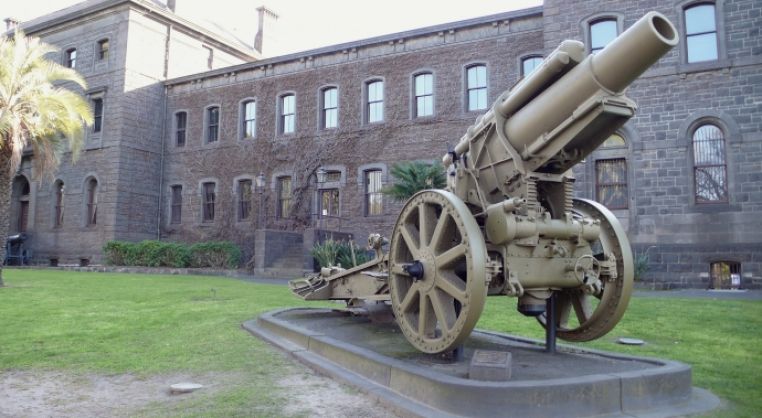Stop 2 is Victoria Barracks
Built in the late 1850s and early 1860s as a base for the British Imperial Forces to defend the colonies, Victoria Barracks played a major role as the headquarters of the Department of Defence including the Australian Army and Royal Australian Navy during WWI.
The next stop is Yarra Bank, otherwise known as Speakers Corner in Birrarung Marr Park via Flinders Street Station.
TRANSCRIPT
RECRUITS WANTED FOR ACTIVE SERVICE ABROAD IN THE AUSTRALIAN IMPERIAL FORCE.
Ages for enrolment, over 18 and under 45 years. Minors must have written consent of parents or guardians.
Apply Victoria Barracks, Melbourne, or to the Mayor or President of Shire in country districts.
– J. C. Hawker, Colonel, Assistant Adjutant-Colonel, 3rd Military District.
At the declaration of WW1 on 5 August 1914, many young men flocked to Victoria Barracks to enlist and join the first contingent of 20,000 troops to Europe. University students, city clerks, bushmen, farmers – all joined up in a spirit of patriotism and adventure.
Victoria Barracks was built in the late 1850s and early 1860s as a base for the British Imperial Forces to defend the colonies.
Following Federation in 1901, Victoria Barracks became the Commonwealth Government’s defence headquarters. And during WW1, Victoria Barracks played a major role as the headquarters of the Department of Defence including the Australian Army and Royal Australian Navy.
All major defence decisions came from here. The Federal Minister for Defence has his office here, as did the Secretary of the Department of Defence. In fact Victoria Barracks remained the headquarters of the Department of Defence until it moved to Canberra in the late 1950s.
Tents were provided for the first recruits in a courtyard of Victoria Barracks. As more enlisted, they were sent to the MCG, Flemington Racecourse or Caulfield Racecourse to sleep in the stands.
And within two weeks of the declaration of war, you would have seen a crowd of 2,500 men leave Victoria Barracks and march to the new military training camp at Broadmeadows.
We left Victoria Barracks at 9.30am, reaching Broadmeadows at 5pm after a picnic lunch at Princes Park. Little did we realise that what we had enlisted for was anything but a picnic – the most brutal and deadly war the world has ever faced.
Limited space at Victoria Barracks led to new buildings being constructed and old ones modified. One was the Guardhouse, which was built in 1862 and refurbished to become Australia’s first defence chemical laboratory. Its role was to provide technical and research information to the munitions factories, in order to attain self-sufficiency in munitions production.
Some other buildings have far more tragic and personal roles – they became storage rooms for deceased soldiers’ personal effects and wills, eventually to be distributed to their families
About 112,400 young Victorians enlisted in the Australian Imperial Force over WW1. Of this some 19,000 were killed in action or died later of their wounds. And many thousands more were wounded, gassed or became prisoners of war.
Bugle call
Military Etiquette, By Jove!
Tis a red-tape not well wove
From the Private to the Colonel
Orders wait a time
Good morning to your Superiors,
Cold stare at your Inferiors
That’s correct, stand erect
Military Etiquette
Respect the OC’s to be paid
When drilling on parade
Stand erect and salute
Don’t look down at your boots
Honour your Superiors
Bully your Inferiors
That’s correct, stand erect
Military Etiquette
Mind your pro’s and con’s
With “May I carry on, Sir?”
Or you’ll get a reprimand
O.C’s always take command
“Sir” to all your Superiors
Swear at your Inferiors
That’s correct, stand erect
Military Etiquette
The next stop is Yarra Bank, otherwise known as Speakers Corner in Birrarung Marr Park via Flinders Street Station.


